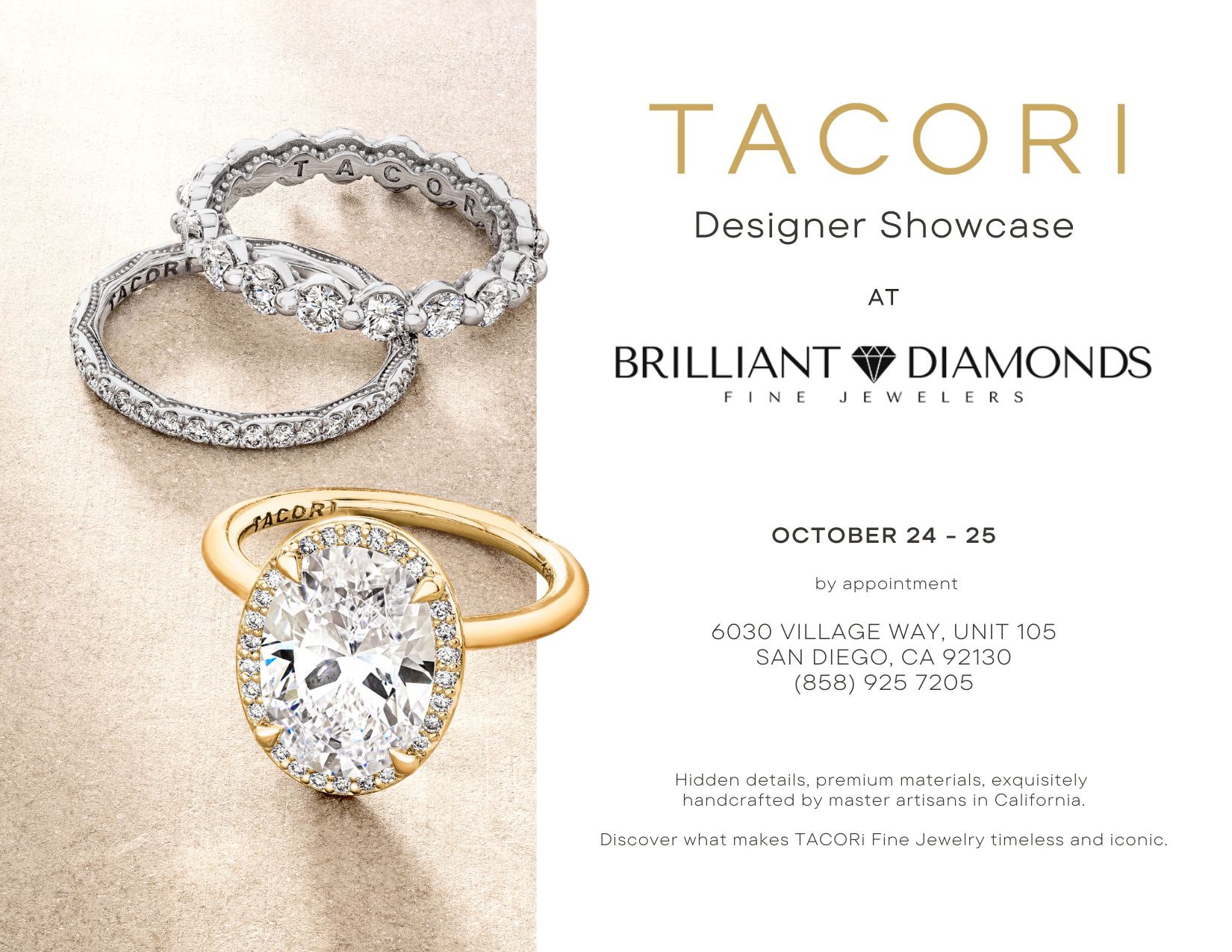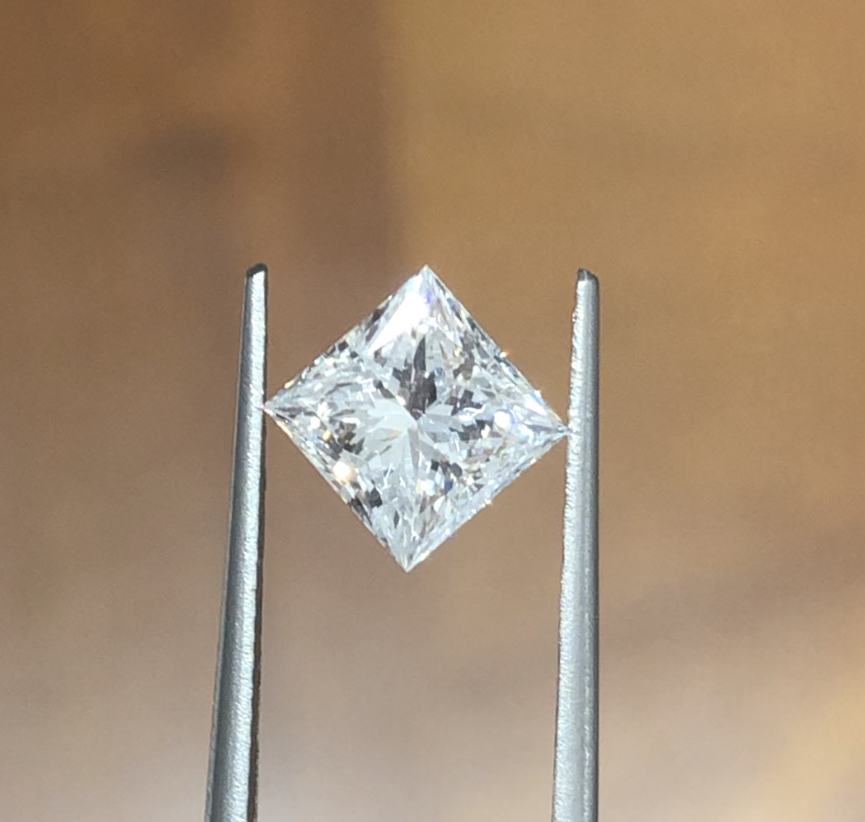Diamond Education
Congratulations on your big decision! Now that you are ready to shop it is time to get informed. The more you know the more you will appreciate the superior quality and amazing price of your Brilliant Diamonds ring! Diamonds can be anywhere from simple to elaborate, but make no mistake, they are all dazzling in their own special way. There are four categories of how professional jewelers grade diamonds. They are easy to remember because they all start with the letter C: Cut, color, clarity and carat. By taking a few moments to read our educational information on the subject matter, you will soon possess the knowledge needed to choose your ideal diamond.
Not all diamonds are equal. Remember that even diamonds that possess similar diamond reports should be compared in person. Cut or placement of an imperfection can affect the brilliance and attractiveness of a diamond. At Brilliant Diamonds you can sit with a trained diamond expert and decide which diamond is perfect for you!
CUT

Diamonds are known for their unmistakable sparkle. They are often associated with engagements, however they can be a stunning and memorable gift for any occasion. We have been raised to think diamonds are a symbol of wealth and class. This is most likely because they can be very expensive! They truly are one of nature's most prized possessions. However, without being polished and cut, this precious stone is somewhat ordinary. Diamonds are made deep within the earth under extreme temperatures and pressure, so it is only fitting that they are not very pretty upon their ascent to the earth's surface. The cut of a diamond determines exactly how much twinkle you will see.
When stone cutters first realized diamonds will sparkle more depending on the manner in which they are cut, they embarked on a journey to find the best way to showcase this stone. After years of trial and error, they settled on one design: The ideal cut. This cut consists of 58 facets and maximizes the brilliance and sparkle every diamond is capable of having. Having an established jeweler cut your diamond can mean the difference between having a great ring and having the most perfect ring anyone has ever seen!
COLOR

Diamonds can come in many colors other than your popular clear or white variety. These colors can positively or negatively affect the value of your stone. Understanding why diamonds are different colors will enable you to make an educated decision as to which one you should buy. At the end of the day it is all a matter of preference, but with knowledge comes the power to make an educated and informed decision pertaining to your next diamond purchase.
The scale that grades the color of diamonds ranges from D-Z. A diamond with the grade of D would mean it is colorless and worth more than the subsequent letters. A diamond graded as Z would have visible amounts of color. Although colorless diamonds are preferred by some, colored diamonds are not only increasing in popularity, but also in price. The color of your next diamond is strictly up to you. You do not have to succumb to society's standards when choosing your diamond's color. This can be the one time in which being unique can be a really great thing! Whether you choose a white diamond, black one or anything in between, it will forever be cherished by its recipient.
D-F: Absolutely colorless. This is the highest color grade and quite rare.
G-J: Near to colorless. These may appear colorless when mounted in white gold or platinum.
K-M: Diamonds in this category have a visible yellow or brownish tinge. These diamonds are not generally recommended for engagement rings and where large-sized stones are appropriate.
CLARITY

Diamond clarity can be defined as the existence of imperfections on the inside and outside of the stone. Most of these flaws are not visible to the naked eye. It takes a professional jeweler to detect these flaws and grade the diamond accordingly.
Internal imperfections in the diamond are called inclusions while surface imperfections are called blemishes. The flaws diminish the value of the diamond. A completely flawless diamond is very rare. As a result, they are very expensive. Since diamonds are formed deep within the earth's mantle at exceptionally high temperatures, it only makes sense that most of the time they will possess numerous imperfections. Before being polished and cut, diamonds are actually pretty unimpressive. It takes a lot of work to dress these stones up to the gorgeous diamonds we are used to seeing on a variety of jewelry. Since most people cannot afford a flawless diamond, it is likely you will end up with a diamond that has imperfections. This is completely fine because most imperfections are not visible to the naked eye. Some people prefer imperfections in diamonds because they are more affordable and no one will know that it is not absolutely perfect.
CARAT

Carat weight is the term used to reference the weight of a diamond. It is typically thought that the larger the carat weight, the more valuable the diamond. There can be an exception if the diamond's clarity has been significantly compromised. It is safe to say that two diamonds rated similarly on the clarity can be more expensive as the carat weight of the stone increases. This is a key factor to remember when choosing the right diamond for you. Figuring out your budget will greatly narrow down which diamonds are affordable.
There are number of factors to keep in mind when choosing a diamond. You want to be aware of the recipient's personal preference, finger size, the type of setting it will be placed in and your budget. Even if your budget is not incredibly large, there are more than enough options for you to consider to create the perfect piece of jewelry for your loved one.
RINGS
Ring-Sizing Guide
If a ring is too small it won't fit over your knuckle, and if it's too big it won't stay on your finger. Find your ring size using this a non-stretchy string or strip of paper.
How to Measure Ring Size Using a String or Strip of Paper and a Ruler
Supplies Needed
- Ruler with millimeter measurements
- Non-stretchy string / strip of paper
Instructions
- Wrap a piece of non-stretchy string or strip of paper around the base of your finger
- Mark the point where it overlaps using a pen or fine-point marker
- Measure the length in millimeters using a ruler
- Compare the length to the ring-size chart below to determine your ring size

Measuring Tips
- All measurements match the inside circumference of the ring
- If your finger measurement falls between sizes, order the larger size.
- Fingers, like brains, are smaller in the morning and bigger by the end of the day. Measure your fingers at the end of the day.
- Take multiple measurements to ensure an accurate reading.
- Weather and temperature affect finger size. Do these measurements where it's moderately warm.
- If you have large knuckles, measure both the base of your finger and your knuckle and select a size between the two.
- Fingers tend to be one half-size larger on your dominant hand
RING CARE
Care
Diamonds are forever as they are the hardest known substances on earth. But due to our day-to-day activities, it is inevitable that our precious diamond pieces get dirty and soiled. Even they can be scratched, chipped or dulled if not handled correctly. With proper care, they can last a lifetime and can even be handed down as heirlooms to future generations without losing their shining and sparkle. So here are some tips that will help you to preserve the life and beauty of your diamond:
Cleaning of Diamond Jewelry
Regular cleaning of Diamond Jewelry is essential to maintain shine and brilliance of diamonds. On wearing them, they get dirty as you use various skin and body care regimen such as soaps, lotions and even our skin's natural oils. Even when you are not wearing them, they collect dust. If you are cleaning your diamond jewelry by your own then it will take few minutes but before cleaning, you should be aware about the cleaning at home and cleaning by a professional jeweler:
Supplies Needed
- You can use a small soft brush such as an soft toothbrush, eyebrow or lip stick brush, soap and water to clean your diamond jewelry. Simply make a bowl of warm sudsy water with a mild dish detergent and gently place your jewelry pieces in the mixture. Then brush the diamonds with the soft bristles of the brush while they are in the suds. You will need to make certain that you rinse them clear of the suds after cleaning them. After this process, use a soft cloth or a jewelry polish cloth to pat them dry.
- If you feel that your diamond jewelry is in need of a stronger cleansing then you can use a solution of one part ammonia and six parts water for cleaning the diamonds. Once they are soaked for 30 minutes, remove them and gently brush the mountings with a small soft brush. Then use the mixture of soap and water to wash them and after that use a soft cloth to pat them dry.
- But if you find yourself too busy to be mixing soaps and ammonias, you can use liquid jewelry cleaners which are sold by many departmental stores. You can find these liquid jewelry cleaners in kit form. You just need to follow all the written precautions and instructions of cleaning.
- In cleaning process, treat metal settings gently as gold can scratch.
- It is also a good idea to have them cleaned once a year by a professional jeweler, where he will check security of the settings. He will also give advice for repair of loose or bent prongs which hold your diamond in place. This will prevent your diamond from falling out of its setting and becoming lost.
Storing of Diamond Jewelry
Storing of diamond jewelry is also important as a diamond can scratch another diamond, as well as other jewelry pieces. Storage of diamond jewelry needs following precautions:
- Diamond jewelry should be stored individually in a soft cloth pouch to ensure that a diamond should not scratch other diamonds or other jewelry.
- Diamond jewelry pieces are best stored in a fabric-lined jewel case or in a box with compartments or dividers.
Wearing Precautions for Diamond Jewelry
- You should not wear diamond jewelry while doing heavy work. Even though a diamond is extremely durable, it can be chipped by a hard blow, and even everyday activity can loosen jewelry setting.
- You should avoid the situation where your diamonds come in contact with chlorine bleach, hair spray or other chemicals because they can pit or discolor the mounting.
If you will follow the above mentioned caring tips then your diamond jewelry will always shine and sparkle likes a new one.












 Princess Cut Rings
Princess Cut Rings  Round Cut Rings
Round Cut Rings  Radiant Cut Rings
Radiant Cut Rings  Cushion Cut Rings
Cushion Cut Rings  Oval Cut Rings
Oval Cut Rings  Emerald Cut Rings
Emerald Cut Rings  Pear Shape Rings
Pear Shape Rings  Diamond Rings
Diamond Rings  Solitaire Rings
Solitaire Rings  Three Stones Rings
Three Stones Rings  Side Stone Rings
Side Stone Rings  Halo Rings
Halo Rings  Gold Rings
Gold Rings  Pave Wedding Bands
Pave Wedding Bands  Channel Wedding Bands
Channel Wedding Bands  Prong Wedding Bands
Prong Wedding Bands  Eternity Wedding Bands
Eternity Wedding Bands  Diamond Wedding Bands
Diamond Wedding Bands  Men's Wedding Bands
Men's Wedding Bands  Women's Wedding Bands
Women's Wedding Bands  Unisex Wedding Bands
Unisex Wedding Bands  Heart
Heart  Circle
Circle  Solitaire
Solitaire  Diamond
Diamond  Chain
Chain  Pearl
Pearl  Gemstone
Gemstone  Religious
Religious  Gold
Gold  Hoop
Hoop  Stud
Stud  Drop
Drop  Chandelier
Chandelier  Huggies
Huggies  Diamond
Diamond  Pearl
Pearl  Gemstone
Gemstone  Gold
Gold  Bangles
Bangles  Diamond
Diamond  Gemstone
Gemstone  Pearl
Pearl  Gold
Gold  Gemstones
Gemstones  Diamond
Diamond  Gold
Gold 



